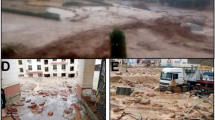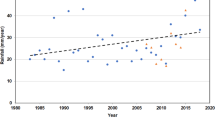Abstract
Flash floods are considered to be one of the worst weather-related natural disasters. They are dangerous because they are sudden and are highly unpredictable following brief spells of heavy rain. Several qualitative methods exist in the literature for the estimations of the risk level of flash flood hazard within a watershed. This paper presents the utilization of remote sensing data such as enhanced Thematic Mapper Plus (ETM+), Shuttle Radar Topography Mission (SRTM), coupled with geological, geomorphological, and field data in a GIS environment for the estimation of the flash flood risk along the Feiran–Katherine road, southern Sinai, Egypt. This road is a vital corridor for the tourists visiting here for religious purposes (St. Katherine monastery) and is subjected to frequent flash floods, causing heavy damage to man-made features. In this paper, morphometric analyses have been used to estimate the flash flood risk levels of sub-watersheds within the Wadi Feiran basin. First, drainage characteristics are captured by a set of parameters relevant to the flash flood risk. Further, comparison between the effectiveness of the sub-basins has been performed in order to understand the active ones. A detailed geomorphological map for the most hazardous sub-basins is presented. In addition, a map identifying sensitive sections is constructed for the Feiran–Katherine road. Finally, the most influenced factors for both flash flood hazard and critical sensitive zones have been discussed. The results of this study can initiate appropriate measures to mitigate the probable hazards in the area.








Similar content being viewed by others
References
Abrahams AD (1984) Channel networks: a geomorphological perspective. Water Resour Res 20:161–168
Ashmawy MH (1994) Assessment of flash flood potential of the Red Sea drainage basins along the Qena–Safaga highway, Eastern Desert, Egypt. ITC J 2:119–128
Band LE (1986) Topographic partition of watersheds with digital elevation models. Water Resour Res 22(1):15–24
Bhuyian C, Singh RP, Flügel WA (2009) Modelling of ground water recharge-potential in the hard-rock Aravalli terrain, India: a GIS approach. Environ Earth Sci 59(4):929–938
Blazkova S, Beven K (1997) Flood frequency prediction for data limited catchments in the Czech Republic using a stochastic rainfall model and TOPMODEL. J Hydrol 195(1–4):256–278
Carlston CW, Langhein NB (1960) Rapid approximation of drainage density: Line intersection method: U. S. Geol. Surv. WRD Bull 11:197–2004
CEOS (2003) The use of earth observing satellites for hazard support: assessments and scenarios. Final report of the CEOS Disaster Management Support Group (DMSG)
Chen J, Hill AA, Urbano LD (2009) A GIS-based model for urban flood inundation. J Hydrol 373:184–192
Chorley RJ, Kennday BA (1971) Physical Geography: a system approach. London, Longman Group Ltd., p 369
Comfort LK (1999) The impact of information technology upon disaster mitigation and management. In: Proceedings of the Second Conference on the Applications of Remote Sensing and GIS for Disaster Management, Washington, DC, CD-ROM
Cunderlik JM, Burn DH (2002) Analysis of the linkage between rain and flood regime and its application to regional flood frequency estimation. J Hydrol 261(1–4):115–131
Egyptian Meteorological Authority (2000) database
El-Etr HA, Ashmawy MH (1993) Flash flood vulnerability and mitigation of the Red Sea basins between Latitudes 24°41′ and 25°26′. Proc. Internat. Conf. “30 years Coop. Geol. Surv., Egypt, Cairo, pp 335–351
El-Shamy IZ (1992a) Recent recharge and flash flooding opportunities in the Eastern Desert, Ann Geol Surv, Egypt, pp 323–334
El-Shamy IZ (1992b) New approach for hydrological assessment of hydrographic basins of recent recharge and flooding possibilities. 10th Symp. Quaternary and Development, Egypt, Mansoura Univ., 18 April, p 15 (Abstract)
Ez Eldeen FK (1989) Topography problems in the Eastern desert Egypt, and their impacts on the roads, Quantitative and analytical study. Bull Geog Soc Egypt 21:79–108 (in Arabic)
Fairfield J, Leymarie P (1991) Drainage networks from grid digital elevation models. Water Resour Res 30(6):1681–1692
Gardiner V (1990) Drainage basin morphometry. In: Goudie AS (ed) Geomorphological techniques. Unwin Hyman, London, pp 71–81
Ghoneim E, El-Baz F (2007) The application of radar topographic data to mapping of a mega-paleodrainage in the Eastern Sahara. J Arid Environ 69(4):658–675
Gurnell AM, Montgomery AR (1999) Hydrological applications of GIS. Wiley, Chichester, p 176
Haeng Heo-J, Salas JD, Boes DC (2001) Regional flood frequency analysis based on a Weibull model, part 2 Simulations and applications. J Hydrol 242(3–4):171–182
Haggatt P, Chorley RJ (1969) Network analysis in Geography. Longman Group Ltd., London, p 34
Hassan OA (2000) Salient Geoenvironmental parameters of Ras Malaab–Abu Zenima Area, Gulf of Suez, Egypt, with an emphasis on flash flood potential and mitigative measures; Egypt. J Remote Sens Space Sci 3:37–58
Hess LL, Melack JM, Simonett DS (1990) Radar detection of flooding beneath the forest canopy: a review. Int J Remote Sens 11:1313–1325
Hess LL, Melack J, Filoso S, Wang Y (1995) Delineation of inundated area and vegetation along the Amazon floodplain with the SIR-C Synthetic Aperture Radar. IEEE T Geosci Remote 33:896–903
Horritt MS, Bates PD (2002) Evaluation of 1D and 2D numerical models for predicting river flood inundation. J Hydrol 268:87–99
Horton R (1945) Erosional development of streams and their drainage basins, hydrophysical approach to quantitative morphology. Geol Soc Am Bull 56:275–370
Krishnamurthy J, Srinivas G, Jayaram V, Chandrasekhar MG (1996) Influence of rock types and structures in the development of drainage networks in typical hard rock terrain. ITC J 3(4):252–259
Krumbein WC, Shreve RL (1970) Some statistical properties of dendritic channel networks, Technical Report No. 13, US. Office of Naval Research Contract Nonr-1228(36), Task No. 389–150
Kumar R, Kumar S, Lohani AK, Nema RK, Singh RD (2000) Evaluation of geomorphological characteristics of a catchment using GIS. GIS India 9(3):13–17
Landau S, Mitchell RAC, Barnett V, Colls JJ, Craigon J, Payne RW (2000) A parsimomious, multiple-regression model of wheat yield response to environment. Agric Forest Meteorol 101(2–3):151–166
Le Toan T, Ribbes F, Wange LF, Floury N, Ding N, Kong KH (1997) Rice crop mapping and monitoring using ERS-1 data based on experiment and modeling results. IEEE T Geosci Remote 35:41–56
Leopold LB, Miller JP (1956) Ephemeral streams: hydraulic factors and their relation to the drainage network, U.S. Geological Survey, prof 282-A
Lubowe JR (1964) Stream junction angles in the dendritic drainage pattern. Am J Sci 262:325–339
Macka Z (2001) Determination of texture of topography from large scale contour maps. Geografski Vestnik 73(2):53–62
Maidment DR (2002) ArcHydro GIS for water resources. Esri Press, California
Manner SB (1958) Factor affecting sediment deposited in the Red Hills Physiographic Area. Trans Amer Geophys Union 39:69–75
Mark DM (1983) Relation between field-surveyed channel network and map-based geomorphometric measures, Inez Kentucky. Ann Assoc Am Geogr 73(3):358–372
Melton M (1957) An analysis of the relations among elements of climate, surface properties and geomorphology, Project NR 389-042, Tech. Rept. 11, Columbia Univ
Miller VC (1953) A quantitative geomorphic study of drainage basin characterize lies in the Clinch Mountain area, Virginia and Tennessee: Columbia Univ., Geol. Dep., Tech. Report No. 3, Contract No. 6, ONR, p 30
Moneim AAA (2005) Overview of the geomorphological and hydrogeological characteristics of the Eastern Desert of Egypt. Hydrogeol J 13(2):416–425
Morisawa ME (1959) Relation of morphometric properties to runoff in the Little Mill Creek, Ohio, Drainage Basin, Tech. rep. 17. Columbia University, Department of Geology, ONR, New York
Morris DG, Heerdegen RG (1988) Automatically derived catchment boundaries and channel networks and their hydrological applications. Geomorphology 1:131–141
Muller EH (1974) Origin of drumlins in glacial geom. In: Cates DR (ed) Glacial morphology. State University of New York, Binghamton, pp 187–207
Nageshwar RB, Bhagabat P (1997) Flood estimation for ungauged catchments using the GIUH. J Water Resour Plan Manag 123:228–238
Ozdemir H, Bird D (2009) Evaluation of morphometric parameters of drainage networks derived from topographic maps and DEM in point of floods. Environ Geol 56(7):1405–1415
Patton PC (1988) Drainage basin morphometry and floods. In: Baker VR, Kochel RC, Patton PC (eds) Flood geomorphology. Wiley, New York, pp 51–65
Pradhan B (2009) Ground water potential zonation for basaltic watersheds using satellite remote sensing data and GIS techniques. Cent Eur J Geosci 1(1):120–129
Pradhan B (2010a) Remote sensing and GIS-based landslide hazard analysis and cross-validation using multivariate logistic regression model on three test areas in Malaysia. Adv Space Res 45(10):1244–1256
Pradhan B (2010b) Flood susceptible mapping and risk area estimation using logistic regression, GIS and remote sensing. J Spatial Hydrol 9(2):1–18
Pradhan B, Lee S (2010a) Delineation of landslide hazard areas on Penang Island, Malaysia, by using frequency ratio, logistic regression, and artificial neural network models. Environ Earth Sci 60(5):1037–1054
Pradhan B, Lee S (2010b) Landslide susceptibility assessment and factor effect analysis: back-propagation artificial neural networks and their comparison with frequency ratio and bivariate logistic regression modelling. Environ Modell Softw 25(6):747–759
Pradhan B, Lee S (2010c) Regional landslide susceptibility analysis using back-propagation neural network model at Cameron Highland, Malaysia. Landslides 7(1):13–30
Pradhan B, Shafie M (2009) Flood hazard assessment for cloud prone rainy areas in a typical tropical environment. Dis Adv 2(2):7–15
Pradhan B, Singh RP, Buchroithner MF (2006) Estimation of stress and its use in evaluation of landslide prone regions using remote sensing data. Adv Space Res 37:698–709
Pradhan B, Shafie M, Pirasteh S (2009) Maximum flood prone area mapping using RADARSAT images and GIS: Kelantan river basin. Int J Geoinform 5(2):11–23
Profeti G, Machintosh H (1997) Flood management though Landsat TM and ERS SAR data: a case study. Hydrol Process 11:1397–1408
Saleh AS (1989) Flash floods in deserts. A geomorphic study of desert Wadis. Institute of Arab Research, Special Studies Series 51:1–93
Sanyal J, Lu XX (2004) Application of remote sensing in flood management with special reference to monsoon Asia—a review. Nat Hazards 33:283–301
Sanyal J, Lu XX (2005) Remote sensing and GIS-based flood vulnerability assessment of human settlements: a case study of Gangetic West Bengal, India. Hydrol Process 19:3699–3716
Schumn SA (1956) Evaluation of drainage system and slopes in badlands at Perth Amboy, New Jersey. Geol Soc Am Bull 67:597–646
Skilodimou H, Livaditis G, Bathrellos G, Verikiou-Papaspiridakou E (2003) Investigating the flooding events of the urban regions of Glyfada and Voula, Attica, Greece: a contribution to Urban Geomorphology. J Geografiska Annaler 85A(2):197–204
Strahler AN (1952) Hypsometric (area–altitude) analysis of erosional topology. Geol Soc Am Bull 63(11):1117–1142. doi:10.1130/0016-7606(1952)63[1117:HAAOET2.0.CO;2]
Strahler A (1964) Quantitative geomorphology of drainage basins and channel networks. In: Chow VT (ed) Handbook of applied hydrology. McGraw-Hill, New York
Strahler A (1991) Hypsometric (area–altitude) analysis of erosional topography. Geol Soc Am Bull 63:1117–1142
Tarboton DG, Bras RL, Rodriguez-Iturbe I (1991) On the extraction of channel networks from digital elevation data. TT Hydrol Process 5:81–100
Townsend PA, Walsh SJ (1998) Modelling flood plain inundation using integrated GIS with radar and optical remote sensing. Geomorphology 21(98):295–312
Verstappen HT (1995) Aerospace technology and natural disaster reduction. In: Singh RP, Furrer R (eds) Natural hazards: monitoring and assessment using remote sensing technique. Pergamon Press, Oxford, pp 3–15
Vincent RK (1997) Fundamentals of geological and environmental remote sensing. Prentice-Hall Inc., Upper Saddle River
Visher GS (1965) Fluvial process as interpreted from ancient and recent fluvial deposits. Soc Econ Pal Min Spe Pub 12:116–132
Yakoo Y, Kazama S, Sawamoto M, Nishimura H (2001) Regionalization of lumped water balance model parameters based on multiple regression. J Hydrol 246(1–4):209–222
Youssef AM, Hegab MA (2005) Using geographic information systems and statistics for developing a database management system of the flood hazard for Ras Gharib area, Eastern Desert, Egypt. The Fourth International Conference on the Geology of Africa 2:1–15
Youssef AM, Pradhan B, Gaber AFD, Buchroithner MF (2009) Geomorphological hazard analysis along the Egyptian Red Sea Coast between Safaga and Quseir. Nat Hazards Earth Sys Science 9:751–766
Zerger A (2002) Examining GIS decision utility for natural hazard risk modeling. Environ Modell Softw 17(3):287–294
Acknowledgments
This manuscript is greatly benefited from the very useful remarks by the anonymous reviewers. Authors would like to thank the reviewers for their constructive comments which helped to bring the paper to bring to the current form.
Author information
Authors and Affiliations
Corresponding author
Rights and permissions
About this article
Cite this article
Youssef, A.M., Pradhan, B. & Hassan, A.M. Flash flood risk estimation along the St. Katherine road, southern Sinai, Egypt using GIS based morphometry and satellite imagery. Environ Earth Sci 62, 611–623 (2011). https://doi.org/10.1007/s12665-010-0551-1
Received:
Accepted:
Published:
Issue Date:
DOI: https://doi.org/10.1007/s12665-010-0551-1




